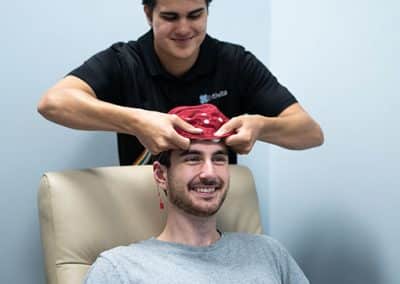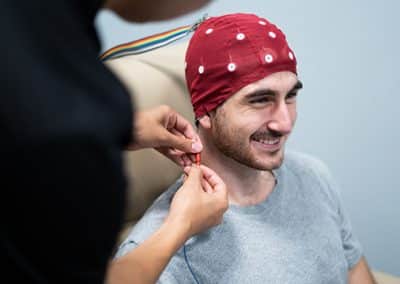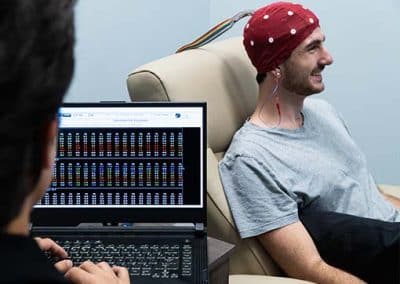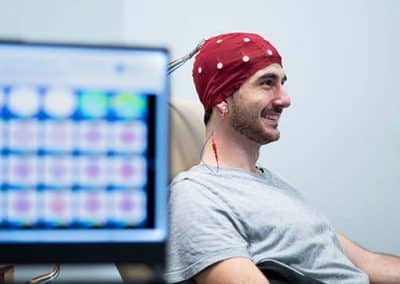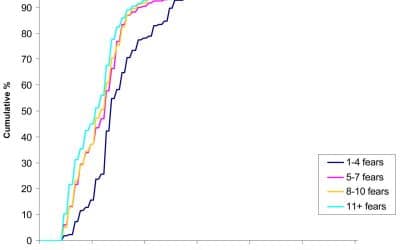Social Anxiety Disorder
People with social anxiety disorder (SAD) are characterized by an extreme fear of social situations. They fear and expect scrutinization/judgement by others in settings such as meeting strangers, being observed in public, and performing in front of others(2). In addition to mental distress, those with SAD often experience physiological symptoms like rapid heart rate, nausea, and vomiting(3). The combination of mental and physiological distress often leads to issues with work and social life, and increases one’s risk of depression, substance-abuse, and even cardiovascular disease(4).
Cognitive behavioral therapy (CBT), medication, or a combination of the two are currently the mainstay treatments for SAD, although certain individuals do not respond well(3). We highly recommend neurofeedback for those not benefitting from CBT or medication, as well as those looking for an alternative therapy with long-term benefits.
Extivita Therapies for Social Anxiety Disorder:
Extivita Therapies for Social Anxiety Disorder:
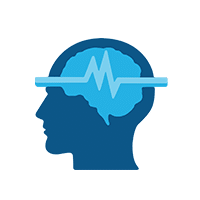
Neurofeedback

Supplements
Neurofeedback Therapy for Anxiety:
Neurofeedback protocols for social anxiety disorder (SAD) typically involve balancing brain activation levels between the right and left side of the brain, specifically in the front of the head. The right side of the brain is believed to be involved in negative thinking and withdrawal behavior, and those with social anxiety have been found to have increased activation in the right frontal region(5-7).
To balance this activity, protocols for SAD may 1) decrease alpha activity it in the left hemisphere or increase it in the right hemisphere and/or 2) increase alpha and theta activity towards the back of the head. The specific protocol for someone with SAD depends on a careful analysis of that individuals qEEG brain map, their behavioral assessment, and their neurofeedback consultation.
News & Research for Social Anxiety Disorder:
Resting and reactive frontal brain electrical activity (EEG) among a non-clinical sample of socially anxious adults: does concurrent depressive mood matter?
Abstract A number of studies have noted that the pattern of resting frontal brain electrical activity (EEG) is related to individual differences in affective style in healthy infants, children, and adults and some clinical populations when symptoms are reduced or in...
Social fears and social phobia in the USA: results from the National Comorbidity Survey Replication
Abstract Background: Despite heightened awareness of the clinical significance of social phobia, information is still lacking about putative subtypes, functional impairment, and treatment-seeking. New epidemiologic data on these topics are presented from the National...
While a phobic waits: regional brain electrical and autonomic activity in social phobics during anticipation of public speaking
Abstract Background: Recent studies have highlighted the role of right-sided anterior temporal and prefrontal activation during anxiety, yet no study has been performed with social phobics that assesses regional brain and autonomic function. This study compared...
References
- Facts & Statistics | Anxiety and Depression Association of America, ADAA. https://adaa.org/about-adaa/press-room/facts-statistics. Accessed 10 Feb. 2021.
- Leichsenring, Falk, and Frank Leweke. “Social Anxiety Disorder.” New England Journal of Medicine, vol. 376, no. 23, Massachusetts Medical Society, June 2017, pp. 2255–64. Taylor and Francis+NEJM, doi:10.1056/NEJMcp1614701.
- Social Anxiety Disorder | Anxiety and Depression Association of America, ADAA. https://adaa.org/understanding-anxiety/social-anxiety-disorder. Accessed 10 Feb. 2021.
- Ruscio, Ayelet Meron, et al. “Social Fears and Social Phobia in the United States: Results from the National Comorbidity Survey Replication.” Psychological Medicine, vol. 38, no. 1, Jan. 2008, pp. 15–28. PubMed Central, doi:10.1017/S0033291707001699.
- Davidson, Richard J., et al. “While a Phobic Waits: Regional Brain Electrical and Autonomic Activity in Social Phobics during Anticipation of Public Speaking.” Biological Psychiatry, vol. 47, no. 2, Jan. 2000, pp. 85–95. ScienceDirect, doi:10.1016/S0006-3223(99)00222-X.
- Beaton, Elliott A., et al. “Resting and Reactive Frontal Brain Electrical Activity (EEG) among a Non-Clinical Sample of Socially Anxious Adults: Does Concurrent Depressive Mood Matter?” Neuropsychiatric Disease and Treatment, vol. 4, no. 1, Feb. 2008, pp. 187–92.
- Moscovitch, David A., et al. “Frontal EEG Asymmetry and Symptom Response to Cognitive Behavioral Therapy in Patients with Social Anxiety Disorder.” Biological Psychology, vol. 87, no. 3, July 2011, pp. 379–85. ScienceDirect, doi:10.1016/j.biopsycho.2011.04.009.

